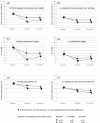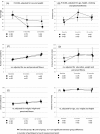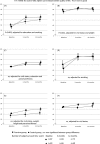Effectiveness of a standardised exercise programme for recurrent neck and low back pain: a multicentre, randomised, two-arm, parallel group trial across 34 fitness clubs in Finland
- PMID: 29021908
- PMCID: PMC5633732
- DOI: 10.1136/bmjsem-2017-000233
Effectiveness of a standardised exercise programme for recurrent neck and low back pain: a multicentre, randomised, two-arm, parallel group trial across 34 fitness clubs in Finland
Abstract
Background: Neck and low back pain (LBP) are common in office workers. Exercise trials to reduce neck and LBP conducted in sport sector are lacking. We investigated the effectiveness of the standardised Fustra20Neck&Back exercise program for reducing pain and increasing fitness in office workers with recurrent non-specific neck and/or LBP.
Method: Volunteers were recruited through newspaper and Facebook. The design is a multi-centre randomised, two-arm, parallel group trial across 34 fitness clubs in Finland. Eligibility was determined by structured telephone interview. Instructors were specially educated professionals. Neuromuscular exercise was individually guided twice weekly for 10 weeks. Webropol survey, and objective measurements of fitness, physical activity, and sedentary behavior were conducted at baseline, and at 3 and 12 months. Mean differences between study groups (Exercise vs Control) were analysed using a general linear mixed model according to the intention-to-treat principle.
Results: At least moderate intensity pain (≥40 mm) in both the neck and back was detected in 44% of participants at baseline. Exercise compliance was excellent: 92% participated 15-20 times out of 20 possible. Intensity and frequency of neck pain, and strain in neck/shoulders decreased significantly in the Exercise group compared with the Control group. No differences in LBP and strain were detected. Neck/shoulder and trunk flexibility improved, as did quality of life in terms of pain and physical functioning.
Conclusions: The Fustra20Neck&Back exercise program was effective for reducing neck/shoulder pain and strain, but not LBP. Evidence-based exercise programs of sports clubs have potential to prevent persistent, disabling musculoskeletal problems.
Keywords: neuromuscular; physical fitness; public health; sports & exercise medicine; sports rehabilitation programs.
Conflict of interest statement
Competing interests: None declared.
Figures




References
LinkOut - more resources
Full Text Sources
Other Literature Sources
Medical
Miscellaneous
